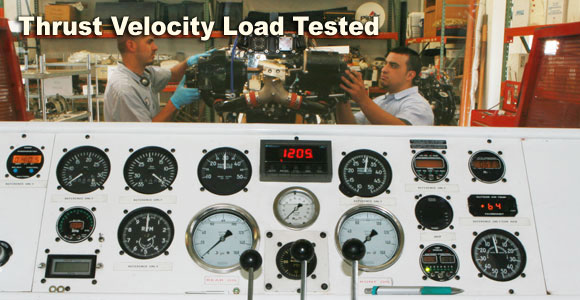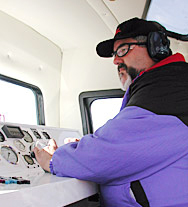
THE
BLACK EDITION™ ENGINE OVERHAUL PROCESS:
THRUST VELOCITY
LOAD TESTED
 Watch the video ! (movie length - 1.5 minute) Watch the video ! (movie length - 1.5 minute)
Completion engine testing is the most rigorous procedure
used anywhere in the world. Victor has a "one-of-a-kind", state-of-the-art
engine test apparatus (nicknamed "Big Red") that measures and records
all engine operating parameters, including engine real-time thrust velocity
output without installing a water brake dynamometer on the engine. We
don't recommend the use of water brake operated dynamometers on aircraft
engines due to the lack  of
velocity load on the engine bearings and crankcase and possible risk of
premature internal engine lubrication problems. of
velocity load on the engine bearings and crankcase and possible risk of
premature internal engine lubrication problems.
The engine is installed into a hydraulic cradle that flexes under torque and
records the actual pulling force of the engine and propeller combination
just as it would in an actual aircraft with accessories and
exhaust system installed. A special flouresant dye is installed into the oil
system throughout the test. Under a black light and canopy, the engine is
stressed to detect the most minute oil leaks.
Through the use and installation of tri-axial piezoelectric
accelerometers, technicians are able to monitor and measure the engine's
internal vibration levels. Any parts that move at a different speed as
compared to the running speed of the engine are detected via the use of
a Full Domain Frequency
Analysis. This analysis is important, because we perform a comparative
computer overlay to determine if any specific part is producing a vibratory
pattern in excess of perfect "real-time balance limits".
This is a mobile apparatus (MTA) designed to run engines at full load with the actual propeller and accessories installed. The complete engine test run process typically requires an average of two workdays. The MTA was created by Victor Sloan with the engineering guidance of former X-15 Rocket Pilot and Propulsion Engineer Scott Crossfield. No other company in the world takes such extreme measures to insure proper quality control.
back |